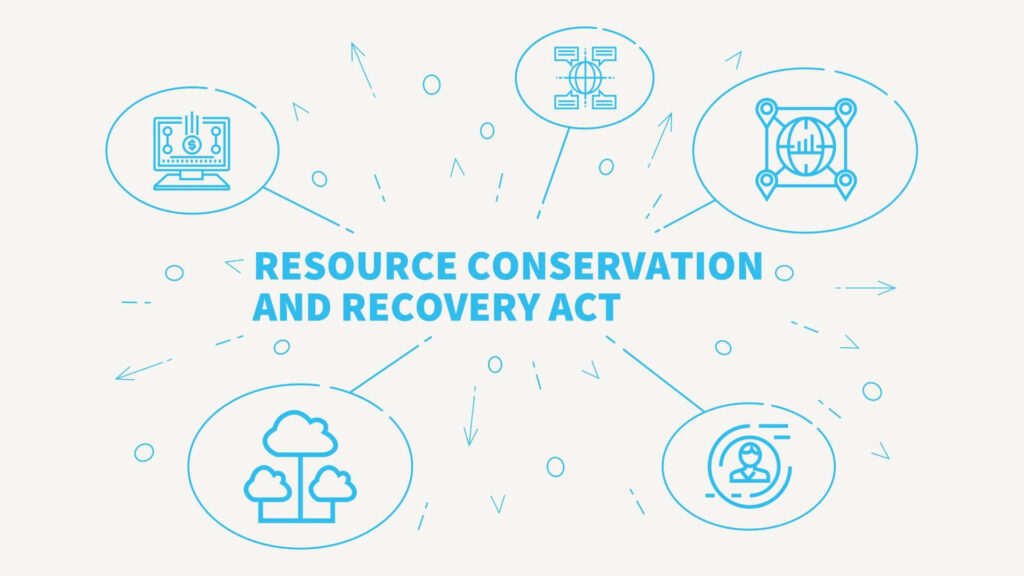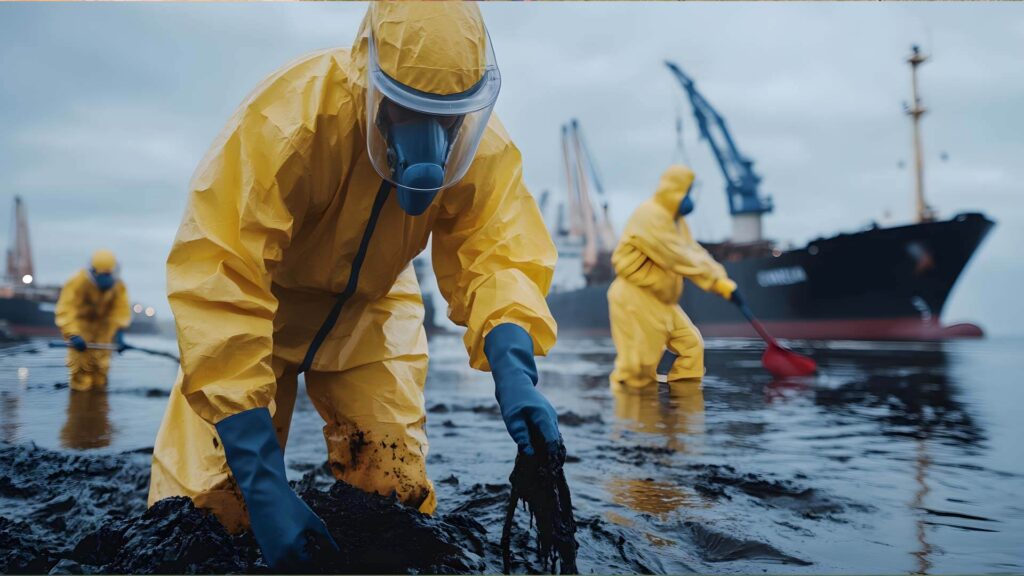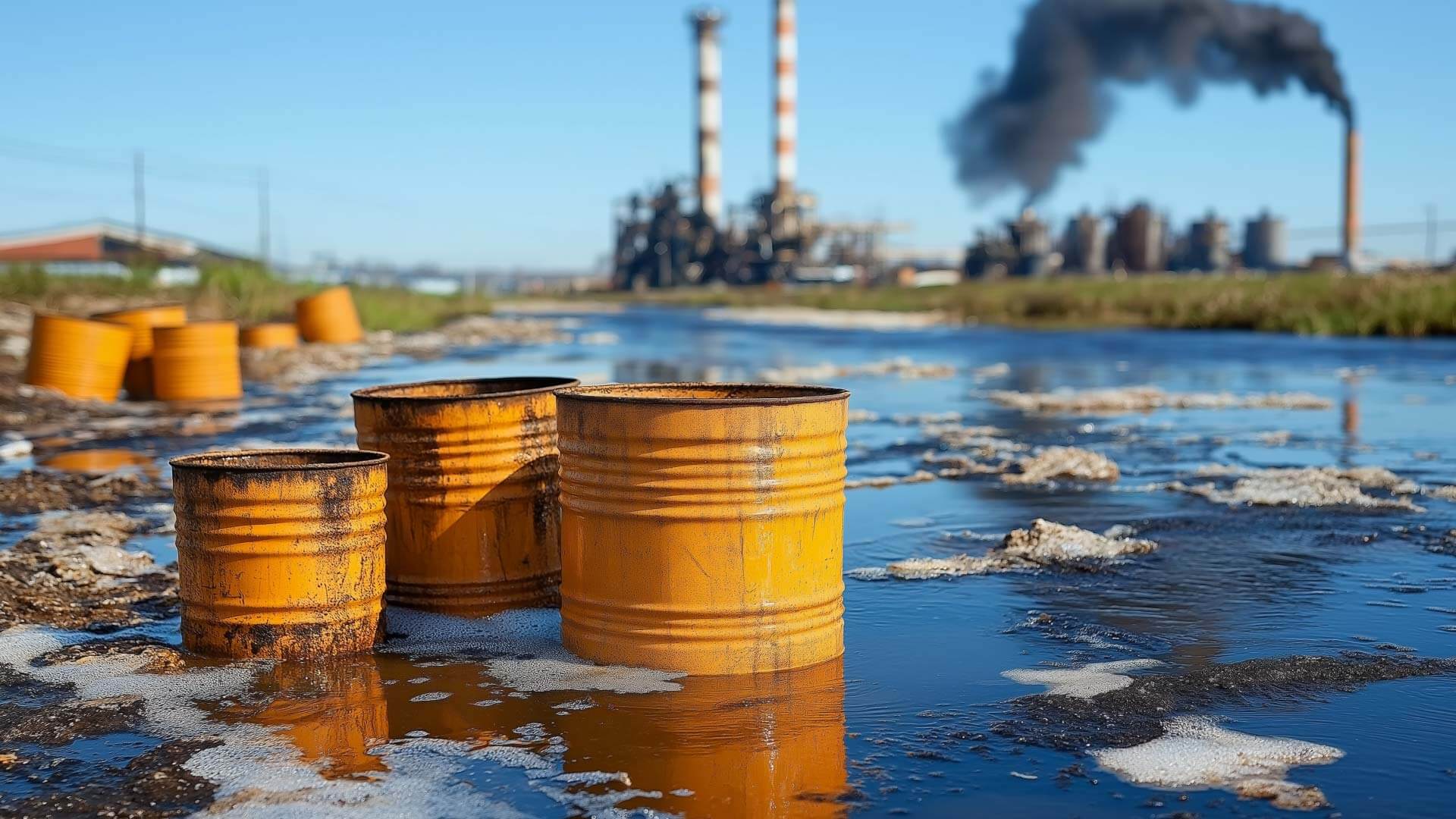Environmental contamination is a growing concern that affects ecosystems, human health, and the overall sustainability of our planet. Pollutants from industrial activities, chemical spills, and improper waste disposal can infiltrate soil, groundwater, and air, leading to severe environmental and public health consequences. Toxic substances such as heavy metals, petroleum hydrocarbons, and hazardous chemicals can disrupt ecosystems, contaminate drinking water sources, and pose long-term risks to wildlife and communities.
Environmental remediation plays a critical role in reversing the damage caused by contamination, restoring polluted sites to safe and usable conditions. By removing or neutralizing harmful pollutants, remediation efforts help mitigate health risks, prevent further environmental degradation, and support ecosystem recovery. These efforts are essential for maintaining biodiversity, ensuring clean water supplies, and protecting air quality.
Environmental remediation services employ a range of advanced technologies and methods to manage contaminated sites effectively. These services include soil and groundwater treatment, bioremediation, chemical stabilization, and excavation, among others. Professional environmental remediation companies specialize in assessing contamination levels, designing tailored cleanup solutions, and ensuring compliance with environmental regulations. Their expertise helps industries, municipalities, and property developers rehabilitate contaminated land for safe and sustainable use.
By integrating environmental remediation into land management strategies, communities can transform hazardous sites into productive spaces, such as parks, commercial developments, and residential areas. These efforts not only protect public health but also contribute to economic growth by revitalizing previously unusable land. With the increasing demand for sustainable solutions, the role of environmental remediation companies continues to expand, driving innovation and efficiency in site restoration.
Understanding Environmental Remediation

What is Environmental Remediation?
Environmental remediation is the process of removing, reducing, or neutralizing pollutants from soil, water, and air to restore affected areas to safe conditions. It involves a combination of physical, chemical, and biological methods to mitigate contamination and prevent further environmental damage. The primary goal of environmental remediation services is to protect human health, preserve ecosystems, and ensure compliance with environmental regulations.
As industrialization and urban development continue to expand, contamination from hazardous substances such as heavy metals, petroleum hydrocarbons, and volatile organic compounds (VOCs) has become a pressing concern. Without proper remediation, these pollutants can persist for decades, causing irreversible damage to natural resources and endangering public health. Environmental remediation companies play a crucial role in addressing these challenges by implementing advanced cleanup technologies and ensuring that contaminated sites are properly managed.
Common Contaminants in Soil, Water, and Air
Environmental pollution can take various forms, affecting different elements of the ecosystem. Some of the most common contaminants include:
- Soil Contaminants:
- Heavy metals (lead, mercury, arsenic, cadmium)
- Petroleum hydrocarbons (gasoline, diesel, crude oil)
- Pesticides and herbicides
- Industrial solvents and polychlorinated biphenyls (PCBs)
- Water Contaminants:
- Chlorinated solvents and VOCs
- Nitrates and phosphates from agricultural runoff
- Heavy metals leaching from industrial sites
- Microbial pathogens and pharmaceuticals
- Air Contaminants:
- Particulate matter (PM2.5, PM10)
- Greenhouse gases (carbon dioxide, methane)
- Volatile organic compounds (benzene, toluene)
- Hazardous air pollutants from industrial emissions
Each of these contaminants poses unique risks to both the environment and public health. For example, heavy metals in soil can accumulate in crops, leading to food chain contamination, while VOCs in groundwater can cause severe health issues when consumed. Environmental remediation companies use specialized treatment methods to address these pollutants, ensuring that affected sites meet safety standards.
Regulatory Frameworks for Environmental Remediation

Environmental remediation services must comply with a range of national and international regulations to safeguard environmental and public health. Governments and environmental agencies have established strict guidelines to ensure proper site assessment, contamination management, and remediation execution.
Key regulatory frameworks governing environmental remediation include:
- The Comprehensive Environmental Response, Compensation, and Liability Act (CERCLA) – Also known as the Superfund Act, CERCLA in the U.S. mandates the cleanup of hazardous waste sites and holds responsible parties accountable for contamination.
- The Resource Conservation and Recovery Act (RCRA) – Establishes guidelines for hazardous waste treatment, storage, and disposal.
- The Clean Water Act (CWA) and Safe Drinking Water Act (SDWA) – Regulate water pollution and ensure the protection of drinking water sources.
- The Clean Air Act (CAA) – Controls air emissions from industrial sources to minimize air pollution and protect public health.
- International Environmental Agreements – Countries worldwide adhere to various environmental treaties, such as the Basel Convention on hazardous waste management and the Stockholm Convention on persistent organic pollutants (POPs).
By adhering to these regulations, environmental remediation companies ensure that cleanup projects meet legal and environmental standards while promoting sustainability. Regulatory compliance is critical in preventing future contamination, mitigating risks, and fostering responsible land development.
Environmental remediation services combine scientific expertise, technological innovation, and strict regulatory adherence to help restore contaminated sites and protect vital natural resources for future generations.
Key Components of Contaminated Site Management

Effective contaminated site management is a critical part of environmental remediation. It ensures that polluted areas are properly assessed, risks are identified, and appropriate cleanup measures are implemented. A comprehensive approach to site management includes detailed evaluation, risk analysis, and the development of site-specific remediation strategies. These steps help environmental remediation companies restore contaminated land while minimizing environmental and health risks.
Site Assessment and Contamination Evaluation
The first step in environmental remediation is conducting a thorough site assessment to determine the type and extent of contamination. This process involves:
- Preliminary Site Investigations: Reviewing historical land use, industrial activities, and potential pollution sources to identify areas of concern.
- Soil and Water Sampling involves collecting and analyzing soil, groundwater, and surface water samples to detect hazardous substances such as heavy metals, petroleum hydrocarbons, and volatile organic compounds (VOCs).
- Air Quality Testing: Measuring airborne pollutants to assess risks associated with industrial emissions or chemical vapors.
- Geotechnical and Hydrogeological Surveys: Examining soil composition, groundwater flow, and geological conditions to determine how contaminants migrate through the environment.
Environmental remediation services can develop an accurate contamination profile by conducting a detailed assessment, which can guide the selection of appropriate remediation techniques.
Risk Analysis and Environmental Impact Assessments
Once contamination is identified, a risk analysis is performed to evaluate its potential effects on human health and the environment. This process includes:
- Human Health Risk Assessment (HHRA) involves examining exposure pathways, such as direct soil contact, groundwater consumption, or inhalation of toxic vapors, to determine health risks for nearby communities.
- Ecological Risk Assessment: Evaluating the impact of contaminants on local wildlife, plant life, and aquatic ecosystems.
- Environmental Impact Assessment (EIA): Identifying short- and long-term consequences of contamination and proposed environmental remediation services, ensuring compliance with regulatory requirements.
- Regulatory Compliance Evaluation: Reviewing local, state, and federal regulations to align cleanup efforts with environmental protection laws.
This risk analysis helps environmental remediation companies prioritize cleanup efforts, allocate resources efficiently, and implement measures that effectively mitigate potential hazards.
Development of Site-Specific Remediation Strategies
Each contaminated site requires a tailored remediation plan based on its unique characteristics, contamination levels, and regulatory requirements. Environmental remediation services develop site-specific strategies that may include:
- Physical Remediation: Excavation, soil washing, and groundwater extraction to remove pollutants from the environment.
- Chemical Treatment: Soil stabilization, oxidation, and neutralization to break down hazardous substances.
- Biological Remediation: Bioremediation and phytoremediation techniques that use microorganisms or plants to degrade contaminants naturally.
- Containment and Risk Mitigation: Installing barriers, liners, or capping techniques to prevent further spread of pollutants.
- Long-Term Monitoring and Maintenance: Continuous site monitoring to ensure remediation success and prevent contamination recurrence.
Environmental remediation companies help industries, municipalities, and developers restore contaminated sites for safe and sustainable use by integrating scientific assessments with advanced remediation technologies. Proper site management protects public health and the environment and enables economic redevelopment, allowing previously hazardous areas to be repurposed for commercial, residential, or industrial applications.
Environmental Remediation Techniques and Technologies
The success of environmental remediation relies on a variety of techniques and technologies designed to remove or neutralize contaminants in soil, water, and air. Environmental remediation services utilize physical, chemical, and biological methods to clean up polluted sites effectively, ensure compliance with environmental regulations, and restore land for safe use. As technology advances, environmental remediation companies are also adopting innovative solutions that enhance efficiency and sustainability in cleanup efforts.
Physical Remediation Methods
Excavation and Soil Washing
One of the most commonly used environmental remediation techniques is excavation, where contaminated soil is physically removed and transported to a treatment facility or designated disposal site. This method is particularly effective for sites with high concentrations of heavy metals, petroleum hydrocarbons, or industrial waste.
Soil washing is often used in conjunction with excavation. It involves separating contaminants from soil particles using water, chemical additives, or mechanical processes. This technique reduces the volume of contaminated soil requiring disposal and allows for potential reuse of cleaned soil. Environmental remediation services often implement soil washing as a cost-effective and environmentally friendly alternative to full excavation.
Groundwater Extraction and Treatment
Groundwater contamination poses significant risks to drinking water supplies and ecosystems. To address this issue, environmental remediation companies use pump-and-treat systems, where contaminated groundwater is extracted from underground sources and treated using filtration, chemical neutralization, or biological processes.
Advanced remediation technologies, such as in-situ groundwater treatment, allow contaminants to be neutralized directly in the subsurface without removing the water. These methods include chemical oxidation, reactive barriers, and bioremediation strategies, making groundwater cleanup more efficient and less invasive.
Chemical Remediation Methods
Chemical Oxidation and Reduction
Chemical oxidation involves introducing oxidizing agents, such as hydrogen peroxide, ozone, or permanganate, into contaminated soil or groundwater to break down organic pollutants. This method is highly effective for treating petroleum hydrocarbons, volatile organic compounds (VOCs), and industrial solvents.
Conversely, chemical reduction uses reducing agents like zero-valent iron (ZVI) to convert hazardous substances into less toxic or inert forms. Environmental remediation services employ this technique to remove contaminants such as chlorinated solvents, heavy metals, and nitrates.
Soil Stabilization and Solidification
Soil stabilization involves adding chemical agents to contaminated soil to immobilize harmful substances and prevent them from leaching into groundwater. This method is commonly used to treat heavy metals and radioactive materials.
Solidification, a related process, encapsulates contaminants using binding materials like cement, fly ash, or lime, reducing their mobility and bioavailability. Environmental remediation companies widely adopt these techniques for managing industrial waste, landfill sites, and hazardous waste facilities.
Biological Remediation Methods
Bioremediation Using Microorganisms
Bioremediation leverages naturally occurring or introduced microorganisms to degrade contaminants in soil and water. Bacteria, fungi, and other microbes metabolize pollutants, breaking them down into non-toxic byproducts. This method is particularly effective for treating petroleum spills, pesticides, and organic solvents.
Certain environmental remediation services enhance bioremediation efficiency by introducing oxygen or nutrients to accelerate microbial activity. This approach, known as bioaugmentation or biostimulation, speeds up the degradation process, making it a cost-effective and environmentally friendly remediation solution.
Phytoremediation with Plants to Absorb Contaminants
Phytoremediation uses plants to absorb, store, or break down pollutants in soil and water. Certain plant species, such as sunflowers, poplars, and willows, can extract heavy metals, hydrocarbons, and pesticides from contaminated environments.
This technique is particularly advantageous for large-scale contamination sites where traditional remediation methods may be too expensive or disruptive. Environmental remediation companies often incorporate phytoremediation in projects that require low-impact, sustainable solutions for long-term site restoration.
Innovative and Emerging Technologies
Nanotechnology Applications in Remediation
Nanotechnology is revolutionizing environmental remediation by introducing engineered nanoparticles that can break down contaminants at a molecular level. For example, nano-scale zero-valent iron (nZVI) is used to degrade chlorinated solvents and other persistent pollutants in groundwater.
These cutting-edge solutions offer faster and more efficient cleanup processes, reducing costs and environmental impact. As environmental remediation services continue to evolve, nanotechnology is expected to play a significant role in addressing complex contamination challenges.
Thermal Desorption and Electrokinetic Remediation
Thermal desorption is a remediation technique that applies heat to contaminated soil or sediments, causing volatile pollutants to evaporate and be captured for treatment. This method is particularly effective for removing hydrocarbons, PCBs, and other persistent organic pollutants.
Electrokinetic remediation, on the other hand, uses an electric field to mobilize contaminants in soil and groundwater. By applying a low-intensity electrical current, heavy metals and organic pollutants can be extracted and treated. This method is especially useful for fine-grained soils where traditional excavation and treatment methods are less effective.
Role of Environmental Remediation Companies
Environmental remediation companies play a crucial role in assessing, planning, and executing cleanup projects to restore contaminated sites. These specialized firms provide environmental remediation services that help industries, municipalities, and property developers mitigate pollution, comply with environmental regulations, and repurpose land for safe and sustainable use. By leveraging advanced technologies and industry best practices, these companies ensure that contaminated sites are properly managed, reducing risks to human health and the environment.
How Environmental Remediation Companies Assess, Plan, and Execute Cleanup Projects

1. Site Assessment and Investigation
The first step in any environmental remediation project is a comprehensive site assessment. This involves:
- Historical Research: Reviewing past industrial or commercial activities to identify potential contamination sources.
- Soil, Water, and Air Testing involves collecting and analyzing samples to determine the type and extent of contamination.
- Risk Analysis: Evaluating the potential impact of pollutants on human health and the surrounding environment.
Using this data, environmental remediation companies develop a site contamination profile, which serves as the foundation for cleanup planning.
2. Developing a Remediation Plan
Once the assessment is complete, remediation experts create a customized strategy to address site-specific contamination challenges. This includes:
- Selecting the Appropriate Remediation Method: Based on the type of contaminant and site conditions, choose from physical, chemical, biological, or innovative technologies.
- Regulatory Compliance Planning: Ensuring the project meets all local, state, and federal environmental regulations.
- Cost and Timeline Estimation: Establishing a budget and realistic timeframe for project completion.
3. Execution and Monitoring
With a plan in place, environmental remediation services begin site cleanup using advanced remediation technologies. Execution involves:
- Contaminant Removal or Neutralization: Implementing remediation techniques such as soil excavation, groundwater treatment, or chemical stabilization.
- Real-Time Monitoring and Adjustments: Continuously measuring contaminant levels to ensure effectiveness and making modifications if necessary.
- Long-Term Maintenance and Reporting: Conducting post-remediation monitoring to confirm site safety and providing compliance documentation.
By following a structured approach, environmental remediation companies ensure successful site restoration while minimizing environmental disruption.
Key Considerations in Selecting a Remediation Service Provider
Choosing the right environmental remediation services provider is critical for effective site cleanup. Organizations should evaluate potential companies based on the following factors:
- Experience and Expertise: Look for environmental remediation companies with a proven track record in handling similar contamination issues.
- Regulatory Knowledge: Ensure the company is well-versed in local, state, and federal environmental laws.
- Technology and Methods Used: A reputable provider should offer a wide range of remediation techniques tailored to specific site conditions.
- Safety and Compliance Standards: Verify that the company follows industry best practices and prioritizes worker and environmental safety.
- Project Management Capabilities: The provider should be able to manage timelines, costs, and stakeholder communication effectively.
Organizations should also review past project references and certifications to confirm the company’s credibility and reliability.
Industry Standards and Best Practices Followed by Reputable Companies
Reputable environmental remediation companies adhere to established industry standards and best practices to ensure safe and effective cleanup. These include:
- Compliance with Environmental Regulations: Adhering to laws such as the Comprehensive Environmental Response, Compensation, and Liability Act (CERCLA), Resource Conservation and Recovery Act (RCRA), and the Clean Water Act (CWA).
- Use of Sustainable and Green Remediation Practices: Minimizing waste, reducing carbon footprints, and incorporating energy-efficient technologies.
- Health and Safety Protocols: Implementing Occupational Safety and Health Administration (OSHA) guidelines to protect workers and communities.
- Advanced Monitoring and Reporting Systems: Using real-time data collection and digital reporting tools to track remediation progress and ensure transparency.
- Quality Control Measures: Conducting rigorous testing before, during, and after remediation to confirm site safety and effectiveness.
By following these standards, environmental remediation services providers enhance the efficiency and credibility of their projects, helping clients achieve long-term environmental sustainability.
Challenges in Environmental Remediation
While environmental remediation is essential for restoring contaminated sites and protecting public health, it also presents several challenges. These obstacles include high cleanup costs, the need for long-term monitoring, and the complexity of navigating evolving environmental regulations. Environmental remediation companies must strategically address these challenges to ensure successful and sustainable site restoration.
Cost Implications and Funding Sources for Cleanup Projects
One of the biggest challenges in environmental remediation is the financial burden associated with cleanup projects. The cost of remediation can vary significantly based on factors such as the size of the contaminated site, the type and extent of pollution, the remediation method used, and regulatory compliance requirements. Common expenses include:
- Site Assessment and Contaminant Testing: Conducting environmental studies, risk assessments, and laboratory analyses.
- Remediation Technology and Equipment: Costs associated with excavation, soil treatment, water filtration, chemical applications, or bioremediation methods.
- Waste Disposal and Management: Transporting and safely disposing of hazardous materials in accordance with environmental laws.
- Project Management and Labor: Hiring skilled professionals and technicians for site remediation and compliance oversight.
To offset these costs, organizations and municipalities often seek funding from various sources, including:
- Government Grants and Programs: Agencies such as the U.S. Environmental Protection Agency (EPA) and state environmental departments offer financial assistance for cleanup efforts.
- Brownfield Redevelopment Incentives: Tax credits and funding programs encourage the remediation and redevelopment of contaminated properties.
- Private Sector Investments: Industrial and commercial stakeholders may fund environmental remediation services to repurpose contaminated land for future use.
- Legal Settlements and Liability Programs: Under environmental laws such as the Comprehensive Environmental Response, Compensation, and Liability Act (CERCLA), polluters may be held responsible for funding cleanup efforts.
Despite these funding options, cost remains a major concern for companies and municipalities seeking environmental remediation services, often requiring strategic financial planning and resource allocation.
Long-Term Monitoring and Maintenance of Remediated Sites
Successfully cleaning up a contaminated site does not mark the end of the remediation process. Many sites require long-term monitoring and maintenance to ensure that contaminants do not resurface and that remedial systems remain effective. Environmental remediation companies must implement post-remediation strategies, including:
- Regular Soil and Water Testing: Ongoing sampling and analysis to detect any signs of residual or migrating contamination.
- Operation and Maintenance of Remedial Systems: Ensuring the continued functionality of groundwater treatment systems, containment barriers, and bioremediation projects.
- Site Inspections and Compliance Audits: Conducting routine checks to confirm that remediated sites meet environmental safety standards.
- Adaptive Remediation Strategies: Adjusting remediation techniques based on monitoring data to address new contamination risks. Ife contaminants persist in the environment, environmental remediation services may require additional intervention over time. Without adequate monitoring, sites can experience recontamination, leading to further environmental and financial consequences.
Compliance with Evolving Environmental Regulations
Environmental remediation companies must navigate an ever-changing regulatory landscape, as environmental laws and cleanup standards continue to evolve. Governments and environmental agencies frequently update policies to address emerging contaminants, strengthen pollution controls, and enhance sustainability requirements. Some key challenges related to compliance include:
- Changing Remediation Standards: Regulatory agencies may impose stricter cleanup thresholds for contaminants such as PFAS (per- and polyfluoroalkyl substances), requiring additional remediation measures.
- Liability and Legal Complexity: Property owners and businesses must ensure compliance with environmental liability laws to avoid fines, legal disputes, and reputational damage.
- Permitting and Approval Processes: Lengthy regulatory approval timelines can delay remediation projects, increasing costs and project complexity.
- State and Federal Coordination: Remediation projects often involve multiple levels of government oversight, requiring coordination between state and federal agencies.
To stay compliant, environmental remediation services providers must stay informed about policy changes, work closely with regulatory bodies, and adopt best practices to ensure legal and environmental standards are met.
Benefits of Effective Environmental Remediation
Environmental remediation is essential for mitigating pollution, restoring ecosystems, and promoting sustainable land use. When executed effectively, environmental remediation services provide significant benefits, from protecting public health and biodiversity to stimulating economic growth and supporting corporate social responsibility initiatives. As industries and governments recognize the value of remediation, environmental remediation companies play a critical role in ensuring long-term environmental sustainability.
Protection of Human Health and Biodiversity
One of the primary goals of environmental remediation is to eliminate or reduce harmful contaminants that pose risks to human health and ecosystems. Pollutants such as heavy metals, petroleum hydrocarbons, volatile organic compounds (VOCs), and hazardous chemicals can infiltrate soil, groundwater, and air, leading to severe consequences. Effective remediation helps:
- Reduce Exposure to Toxic Substances: Cleanup efforts remove pollutants from the environment, minimizing the risk of respiratory illnesses, neurological disorders, and other health complications.
- Improve Water Quality: Environmental remediation services treat contaminated groundwater and surface water, environmental remediation services ensure access to clean drinking water.
- Restore Ecosystem Balance: Contaminated sites can devastate local flora and fauna. By eliminating pollutants, remediation helps reestablish natural habitats, supporting plant and animal populations.
- Enhance Soil Fertility: Removing hazardous waste from soil improves land quality, making it suitable for agriculture, conservation, and sustainable land use.
By prioritizing public health and environmental safety, environmental remediation companies contribute to a cleaner, healthier future for communities and ecosystems.
Economic Benefits of Land Restoration and Redevelopment
Beyond environmental and health advantages, environmental remediation plays a key role in economic development. Many contaminated sites, particularly brownfields, hold significant potential for redevelopment once properly remediated. The economic benefits include:
- Increased Property Values: Remediated land can be repurposed for residential, commercial, or industrial use, increasing its market value and attracting investors.
- Job Creation and Economic Growth: Remediation projects generate employment opportunities for environmental engineers, construction workers, scientists, and other professionals in the field.
- Revitalization of Urban Areas: Cleaning up polluted industrial zones or abandoned sites encourages new businesses, housing developments, and infrastructure projects.
- Enhanced Tax Revenue for Local Governments: Redeveloped land leads to increased property taxes, sales taxes, and business investments, benefiting local economies.
Environmental remediation services help cities and communities thrive by converting contaminated areas into valuable real estate, environmental remediation services help cities and communities thrive while ensuring that land is used sustainably.
Contribution to Corporate Social Responsibility and Sustainability Goals
Many industries and businesses recognize the importance of environmental remediation as part of their corporate social responsibility (CSR) and sustainability initiatives. Proactive environmental cleanup aligns with global sustainability goals and demonstrates a commitment to environmental stewardship. Key CSR benefits include:
- Regulatory Compliance and Risk Reduction: Proactive remediation helps businesses meet environmental regulations, reducing the risk of legal action, fines, and reputational damage.
- Enhanced Brand Reputation: Companies that invest in environmental remediation services demonstrate social and environmental responsibility, gaining public trust and support.
- Sustainable Business Practices: Restoring contaminated land contributes to a company’s overall sustainability efforts, helping meet carbon footprint reduction targets and green business certifications.
- Long-Term Environmental Protection: Investing in environmental remediation companies ensures that businesses minimize their impact on ecosystems and contribute to long-term conservation efforts.
As environmental regulations become more stringent and stakeholders demand greater sustainability efforts, environmental remediation companies play a crucial role in helping businesses align with CSR objectives and meet global sustainability standards.
Conclusion
Effective environmental remediation is essential for restoring contaminated sites, protecting human health, and ensuring the sustainability of our natural resources. By employing advanced remediation technologies and following regulatory frameworks, environmental remediation services help mitigate the risks associated with hazardous pollutants in soil, water, and air. As industries, municipalities, and property developers continue to address environmental contamination, the role of environmental remediation companies remains critical in transforming polluted land into safe, usable spaces. These efforts not only safeguard ecosystems but also contribute to economic development by revitalizing once-unusable land for commercial, residential, and industrial purposes.
As environmental concerns and regulatory standards continue to evolve, the demand for innovative and cost-effective environmental remediation services will only increase. Businesses and communities that invest in remediation not only ensure compliance with environmental laws but also demonstrate a commitment to corporate social responsibility and sustainability. With continued advancements in remediation technologies and growing awareness of environmental protection, environmental remediation companies will play a leading role in shaping a cleaner, healthier future for generations to come.



